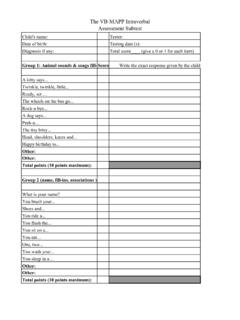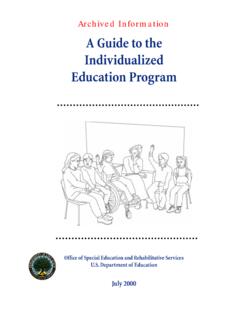Transcription of Verbal Behavior Milestones Assessment and Placement ...
1 7/28/2016. Verbal Behavior Milestones Assessment and Placement Program: Overview, Administration and Programming Guidelines Thursday, August 4, 2016. National Autism Conference Heather Forbes, MA, CCC-SLP, BCBA. Amy Naccarelli, , BCBA. Pennsylvania Training and Technical Assistance Network PaTTAN's Mission The mission of the Pennsylvania Training and Technical Assistance Network (PaTTAN) is to support the efforts and initiatives of the Bureau of Special Education, and to build the capacity of local educational agencies to serve students who receive special education services. 1. 7/28/2016. PDE's Commitment to Least Restrictive Environment (LRE). Our goal for each child is to ensure Individualized Education Program (IEP). teams begin with the general education setting with the use of Supplementary Aids and Services before considering a more restrictive environment. Pretest: True or False?
2 The VB-MAPP is a curriculum. 2. 7/28/2016. Pretest: True or False? It is recommended to always administer the VB-MAPP Assessment from the bottom-up . (earlier Milestones to later Milestones ). Pretest: True or False? It is important to record specific student responses when administering the VB-MAPP. 3. 7/28/2016. Pretest: True or False? You should use the VB-MAPP Milestones to determine when to move on to the next program. Agenda Overview of operant analysis and Verbal Behavior VB-MAPP: Design and administration guidelines Supplemental Assessment tools and tips Interpreting Assessment results Organizing materials based on the VB-MAPP. General programming considerations 4. 7/28/2016. OPERANT ANALYSIS AND. Verbal Behavior . A-B-C Analysis (Operant Analysis). A=antecedent: What happens before Behavior B= Behavior : What the individual does C=consequence: What happens after Behavior When analyzing all teaching interactions, including social interactions, consider the Antecedents, Behavior , and Consequences 5.
3 7/28/2016. Operant Analysis Video The Operant Analysis Antecedent Behavior Consequence Motivating Operation Response Reinforcement (MO) What student does Increases future Alters value of Observable/Measurabl probability of Behavior reinforcer e Evokes/ Abates Behavior Discriminative Punishment Stimulus (SD) Decreases future Signals availability of probability of Behavior reinforcement Prompts Extinction Procedural use of Reinforcement no discriminative stimuli longer happens Behavior fades 6. 7/28/2016. Verbal Behavior Skinner (1957) proposed that language is learned Behavior we are not born with prior knowledge of how to use language. Language involves a social interaction between speakers and listeners. Verbal Behavior involves all of the movements of a person that are reinforced by a listener who has been trained to do so. Form and Function of Verbal Behavior Form: how the response sounds or looks For example, signing book is different from saying book.
4 Function: when/ why we say what we say For example, the word book can be used in a variety of different ways. I can say book: . When I want a book When I see a book In response to someone else saying, Book . In response to someone asking, What can you find in a library? . 7. 7/28/2016. Verbal Operants Having acquired one functional use of a word does not predict that it will be used for other functions. In order to teach our students to be able to use words across all their functions, we need to know the different functions of language ( Verbal OPERANTS) and understand the operant analysis of each of these. Verbal Operants Verbal Antecedent Behavior Consequence Operant Mand Motivative Operation Verbal Behavior Direct reinforcement (wants cookie) (says cookie ) (gets cookie). Tact Sensory Stimuli Verbal Behavior Non-specific (sees or smells (says cookie ) reinforcement cookie) (gets praised, for instance).
5 Intraverbal Verbal stimulus Verbal Behavior Non-specific (someone says: (says cookie ) reinforcement "What do you eat? ) (gets praised, for instance). Echoic Verbal Stimulus Verbal Behavior : Non-specific (someone says repeats all or part of reinforcement cookie ) antecedent (gets praised, for (says cookie ) instance). 8. 7/28/2016. Other Relevant Operants Operant Antecedent Behavior Consequence Listener Verbal stimulus Non- Verbal Behavior Non-specific Response (someone says (child touches reinforcement touch cookie ) cookie) (gets praised, for instance). Imitation Non- Verbal Non- Verbal Behavior Non-specific Behavior (person with point to point reinforcement (example: Point to point performs an correspondence praise; you're right!', correspondence action, etc.) (person imitates 'great job!' high five, pat Mimetic same action) on back, etc.). Match to Non- Verbal Non- Verbal Behavior Non-specific sample Behavior (in presence of one reinforcement (example: (presentation of stimuli, a second praise; you're right!)))
6 ', stimuli) stimuli is selected 'great job!' high five, pat with shared on back, etc.). properties). Let's Practice As a result of: One has a This is a: tendency to: Seeing a grape Say grape . Hearing a horn Say truck . Wanting a push on the Say push . swing Being told to stand up Standing up Someone says door Say door . Someone says door Say keyhole . Smelling smoke Say barbeque . Seeing a cloud Say white . 9. 7/28/2016. Let's Practice As a result of: One has a This is a: tendency to: Wanting to buy a book Ask where's my wallet? . Seeing banana Say yellow . Hearing banana Say yellow . Hearing cowboy Say boy . Being presented with a task Say later . Seeing teacher Say go away . Seeing teacher while getting Say can I have a marker? . ready for an activity Seeing teacher Say teacher . Hearing teacher Say teacher . VB-MAPP. 10. 7/28/2016. What is the VB-MAPP? Verbal Behavior Milestones Assessment and Placement Program VB-MAPP provides information on a student's acquisition of Verbal operants VB-MAPP as Criterion Level Assessment Assessment and instruction systems are probably most effective when they are integrated and form a feedback loop The VB-MAPP provides a formative Assessment that guides more fine grained analysis of student performance and instructional effectiveness 11.
7 7/28/2016. Program Components Fit Together Data Systems Materials Assessments Organization VB-MAPP. Staff Training/ Program/ Target Treatment Fidelity Selection Teaching Procedures VB-MAPP Video 12. 7/28/2016. Why the VB-MAPP? Assesses acquisition of Verbal operants as defined by Skinner, 1957. Is designed to be easy and time efficient to administer Allows more detailed analysis of skill sets (task analysis) when needed Links to typical development Includes components that can assist in trouble shooting instruction (barriers Assessment ) and aid in transition to less restrictive environments (transition Assessment ). VB-MAPP Overview Guidebook and Protocol Booklet 5 Components: VB-MAPP Milestones Assessment VB-MAPP Barriers Assessment VB-MAPP Transitions Assessment VB-MAPP Task Analysis and Skills Tracking VB-MAPP Placement and IEP goals (only in the guidebook). Resources: 13.
8 7/28/2016. Guidebook 10 Chapters 1. A Behavioral Approach to Language Assessment 2. General Administration Guidelines 3. Milestones Scoring Instructions: Level 1. 4. Milestones Scoring Instructions: Level 2. 5. Milestones Scoring Instructions: Level 3. 6. The Barriers Assessment Scoring Instructions 7. The Transition Assessment Scoring Instructions 8. Interpreting the Level 1 Assessment : Curriculum Placement and Writing IEP goals 9. Interpreting the Level 2 Assessment : Curriculum Placement and Writing IEP goals 10. Interpreting the Level 3 Assessment : Curriculum Placement and Writing IEP goals Guidebook Highlights Summary of a behavioral approach to language Distinction between speaker and listener Form and function Units of analysis (MO/Sd variables-response- consequence). Distinctions between Verbal operants Tips for tester Materials list Scoring guidelines for all sections Curriculum Placement and IEP goal development guide 14.
9 7/28/2016. VB-MAPP Milestones Assessment 3 levels 16 milestone areas 170 measurable Milestones Levels Linked to Developmental Sequences Level 1= 0-18 months Level 2= 18-30 months Level 3= 30-48 months Developmental levels determined by tryout sample with typical children and calibrated with normative samples from other established language instruments. Age ranges are approximate. 15. 7/28/2016. Skill Area Level 1 Level 2 Level 3. Mand X X X. Tact X X X. Listener Resp. X X X. VP/MTS X X X. Play X X X. Social X X X. Imitation X X. Echoic X X. Vocal X. LRFFC X X. IV X X. Group X X. Linguistics X X. Reading X. Writing X. Math X. TOTAL: 9 12 13. VB-MAPP Assessment Grid Provides a graphic presentation of Assessment results and progress between re- assessments Allows simultaneous display of 4. assessments at different points in time 16. 7/28/2016. Administering VB-MAPP Milestones 5 items in each domain at each level Each milestone scored 1, , or 0.
10 Items assessed by: Direct testing (D). Observation (O). Either direct testing or observation (E). Timed observation (TO). Prepare and label materials! Commercial kits are available (but not necessary). See VB-MAPP Kit Contents 17. 7/28/2016. Milestones Assessment Scoring Guidelines Correct responses: Instructor can reliably evoke the Behavior on demand Instructor specifically observes it All relevant variables in place Errors: Wrong response No response in 3 seconds (not fluent). Self-corrections/scrolling (unsure/guessing). Stop Assessment if child misses 3 Milestones in a row per skill area EESA: Early Echoic Skills Assessment Neurotypical Level on Group Points Specific Speech Skills Age VB-MAPP. 1 25 Vowels, diphthongs, some Up to 18 months Level 1. early consonants 2 30 Early consonants, 2-syllable combinations 3 30 Early consonants, 3-syllable combinations 18-30 months Level 2.













